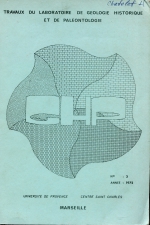Travaux du laboratoire de geologie historique et de paleontologie
The upper cretaceous fresh-water deposits (Rognacian) have been the purpose of a new study which allows : first, to precise the stratigraphie notions already established, and also, to make obvious some general features of paleoeco-logy and paleogeography.
Thanks to different sections, a detailed analysis was done : which was mostly based on the microscopic observation and allowed to define, qualitatively and quantitatively, different types of microfacies.
Different factors characterize these microfacies : sedimentological factors (nature of the cement, structures, figures of alteration, minerals...) and paleontological ones.
Close correlations appear between the lithological facies and the biological ones ; the geographical repartition in particular, is identical and allows to set up a paleobiogeographical reconstitution of the provencal lake during the Rognacien.
Three superposed regions can be found from South to North :
- a fluviatile channel shifts widely in the South (about the "Etang de Berre"). The algal balls accumulations are abundant there,
- an East-West very broad and rather low gut lays in the central regions (about Aix-en-Provence) there, sediments have settled, alternatively calcareous (still in a lacustral environment) and sandeous( fluviatile sedimentation) .
The edges of this gut are represented by zones of high fenny shoals.
- We can infer the proximity of an emerged continent from the decrease of depth in the limestone of Rognac and the presence of some sedimentological and paleontological factors.




